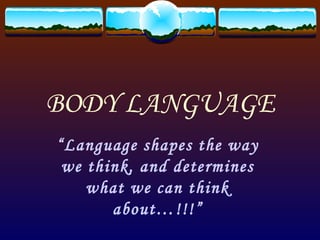
Body language
- 1. BODY LANGUAGE “Language shapes the way we think, and determines what we can think about…!!!”
- 2. Body language comes in clusters of signals and postures, depending on the internal emotions and mental states. Aggressive body language: Showing physical threat. Bored body language: Just not being interested. Closed body language: Many reasons are closed. Deceptive body language: Seeking to cover up lying or other deception. Defensive body language: Protecting self from attack.
- 3. Emotional body language: Identifyingfeelings. Evaluating body language: Judging and deciding about something. Open body language: Many reasons for being open. Power body language: Demonstrating one's power. Relaxed body language: Comfortable and unstressed. Submissive body language: Showing you are prepared to give in.
- 4. AGGRESSIVE BODY LANGUAGE Facial Signals: Much aggression can be shown in the face, from disapproving frowns and pursed lips to sneers and full snarls. Attack Signals: When somebody is about to attack, they give visual signal such as clenching of fists ready to strike and lowering and spreading of the body for stability. Exposing Oneself: It can include not looking at the other person, crotch displays, relaxing the body, turning away and so on.
- 5. BORED BODY LANGUAGE Distraction: A bored person looks anywhere but at the person who is talking to them. They find other things to do, from doodling to talking with others to staring around the room. Repetition: Bored people often repeat actions such as tapping toes, swinging feet or drumming fingers. The repetition may escalate as they try to signal their boredom.
- 6. CLOSED BODY LANGUAGE Arms Cross: In a closed positions one or both arms cross the central line of the body. They may be folded or tightly clasped or holding one another. There may also be holding one another. Legs Cross: When legs are crossed but arms are not, it can show deliberate attempts to appear relaxed. This is particularly true when legs are hidden under a table. Looking down or away: The head may be inclined away from the person, and particularly may be tucked down.
- 7. DECEPTIVE BODY LANGUAGE Anxiety: A deceptive person is typically anxious. This may include sweating, sudden movements, minor twitches of muscles (especially around the mouth and eyes), changes in voice tone and speed. Control: In order to avoid being caught, there may be various signs of over-control. For eg.:forced smiles, jerky movements,etc. Distracted: A person who is trying to deceive needs to think more about what they are doing, so they may drift off or pause as they think about what to say or hesitate during speech.
- 8. DEFENSIVE BODY LANGUAGE Covering vital organs: In physical defense, the defensive person will automatically tend to cover those parts of the body that could damaged by an attack. Fending off: Arms may be held out to fend off attacker, possibly straight out or curved to deflect incoming attacks. Seeking escape: Flicking the eyes from side to side shows that the person is looking for a way out.
- 9. EMOTIONAL BODY LANGUAGE Anger: It occurs when achievement of goals are frustrated. Examples are red face, baring of teeth, clenched fists, invasion of body space, etc. Fear and nervousness: Fear occurs when basic needs are threatened. Examples are cold sweat, pale face, damp eyes, varying speech tone, etc. Sadness: It indicates a depressive state. Examples are drooping of body, flat speech tone, etc.
- 10. EVALUATING BODY LANGUAGE Hand movements: The classic signal of evaluation is the steeped hands which are clasped together, either looking like they are praying, with both hands pressed together, or with linked fingers and with index fingers only pointing upwards. Relaxed intensity: The body may well be relaxed and open. The person seems to be unafraid or even unaware of danger. However there is also a level of concentration, perhaps with pursed lips and an intense gaze. The chin may be resting in one or both palms.
- 11. OPEN BODY LANGUAGE Arms & Legs open: Arms and legs are not crossed. For example appearing to hold things and form more detailed shapes. Looking around and at the other person: The head may be directed solely towards the other person or may be looking around. Eye contact is likely to be relaxed and prolonged. Relaxed clothing: Clothing is likely to hang loosely and actions to loosen clothing may take place.
- 12. POWER BODY LANGUAGE Handshake: As the other person approaches, move to left side, extend your arm horizontally, palm down (be first to do this). Grab their palm firmly, pull them in and hold their elbow with your left hand. Touching: Touching is power symbol. Touching people can be threatening, and is used by leaders to demonstrate power. Talking & Emoting: Talk with confidence and use the body beat in time with assertions. It is also powerful to show that you have emotion, but in the right place only.
- 13. RELAXED BODY LANGUAGE Torso: The torso may sag slightly to one side (but not be held there by irregular tension). It may also be well- balanced, with the shoulders balanced above the pelvis. Breathing: Breathing is steady and slower. This may make the voice a little lower than usual. Relaxed limbs: Relaxed limbs hang loosely. They do not twitch and seldom cross one another, unless as a position of comfort.
- 14. SUBMISSIVE BODY LANGUAGE Body Positions: The body in fearful stances is generally closed, and may also include making the body small and motionless. Submissive Gestures: There are many gestures that have the primary intent of showing submission and that there is no intent to harm the other person. Hands out and palms up shows that no weapons are held and is a common pleading gesture.
